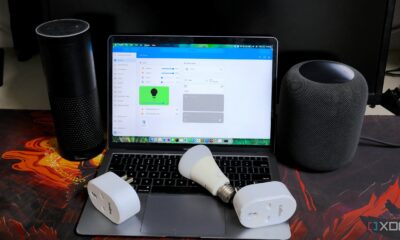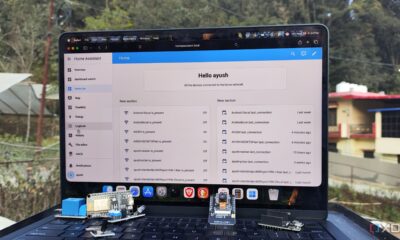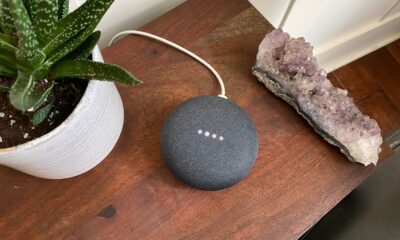Technology
Discover 5 Open-Source Hardware Projects That Cost Under $50

Consumer technology is becoming increasingly proprietary, often leaving users with limited control over their devices. Many consumers are seeking alternatives that promote privacy and customization. This article highlights five open-source hardware projects, each costing less than $50, that can effectively replace mainstream gadgets while providing greater user autonomy.
DIY Smart Display as a Personalized Dashboard
One of the first devices many users consider replacing is the smart display, often epitomized by the Google Nest Hub. While these devices come equipped with voice assistants and multimedia capabilities, they often feel bloated for those who simply want a straightforward interface for essential data. The ESP32 microcontroller serves as an excellent platform for a DIY smart display project.
Utilizing a 3.2-inch touchscreen, users can create a customized dashboard to display the time, weather, and manage smart-home controls. By pairing ESPHome with Home Assistant, the entire setup can be completed for under $50, depending on the chosen display components. This project not only saves money but also empowers users to design a device tailored to their specific needs.
E-Paper Status Board as an Affordable Alternative
For those interested in a more minimalist approach, an e-paper status board offers a simple yet elegant solution reminiscent of products like Tidbyt, but without the high price tag. Building an e-paper board is straightforward and can be accomplished using an ESP32 for a cost-effective solution. This device uses minimal components and can display essential information efficiently.
Smart Speaker Built for Privacy
While smart speakers provide convenience, they often come with concerns over privacy due to their always-on microphones and data collection practices. A DIY smart speaker can alleviate these worries. By using a microcontroller or single-board computer (SBC) alongside a USB microphone and a powered speaker, users can create a smart assistant that operates entirely offline.
This setup allows for local processing of voice commands and even text-to-speech capabilities, linking seamlessly to Home Assistant for voice-controlled lighting and music. While the overall cost may exceed $50, the potential savings compared to commercial alternatives justify its inclusion on this list.
Raspberry Pi for Enhanced Networking Control
The Raspberry Pi is a versatile tool that can replace several devices in a home network, particularly routers, VPNs, and ad-blockers. With software like OpenWrt, a Raspberry Pi can be transformed into a fully functional home router, providing users with more control over their internet connectivity.
If replacing the existing router is not feasible, it can still be operated in bridge mode. Additionally, using Wireguard software, users can establish a private VPN, removing the need for commercial services. Pairing this with Pi-hole for ad-blocking makes the Raspberry Pi a formidable backbone for home networking, all for an estimated cost of $40-$50.
ESP32 Sensor Nodes for Smart Home Integration
The affordability of the ESP32 board makes it a popular choice for various sensor projects. Users can create sensor nodes for monitoring temperature, humidity, or even soil moisture, all while integrating with Home Assistant for a streamlined home automation experience.
For example, a humidity sensor can be paired with a BME680 for real-time monitoring, while motion sensors can utilize the HC-SR501 model to trigger automations. These projects not only provide practical applications but also promote a cloud-free environment, eliminating the need for subscriptions or external data collection.
Overall, these open-source projects highlight the potential for users to reclaim control over their technology. While they may require some technical skill and setup time, the rewards include not only cost savings but also a deeper understanding of the technology at hand. By transitioning from consumer gadgets to self-built solutions, individuals can enjoy enhanced privacy and adaptability, setting a new standard in personal technology.
-

 Technology5 months ago
Technology5 months agoDiscover the Top 10 Calorie Counting Apps of 2025
-

 Technology2 weeks ago
Technology2 weeks agoOpenAI to Implement Age Verification for ChatGPT by December 2025
-

 Health3 months ago
Health3 months agoBella Hadid Shares Health Update After Treatment for Lyme Disease
-

 Health3 months ago
Health3 months agoAnalysts Project Stronger Growth for Apple’s iPhone 17 Lineup
-

 Health3 months ago
Health3 months agoErin Bates Shares Recovery Update Following Sepsis Complications
-

 Technology5 months ago
Technology5 months agoDiscover How to Reverse Image Search Using ChatGPT Effortlessly
-

 Technology3 months ago
Technology3 months agoElectric Moto Influencer Surronster Arrested in Tijuana
-

 Technology2 months ago
Technology2 months agoDiscover 2025’s Top GPUs for Exceptional 4K Gaming Performance
-

 Technology5 months ago
Technology5 months agoMeta Initiates $60B AI Data Center Expansion, Starting in Ohio
-

 Technology5 months ago
Technology5 months agoRecovering a Suspended TikTok Account: A Step-by-Step Guide
-

 Health5 months ago
Health5 months agoTested: Rab Firewall Mountain Jacket Survives Harsh Conditions
-

 Lifestyle5 months ago
Lifestyle5 months agoBelton Family Reunites After Daughter Survives Hill Country Floods





















